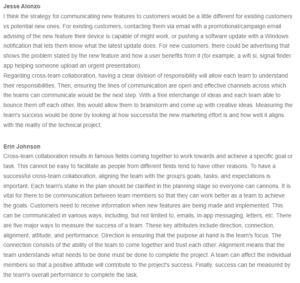Cross-Team Collaboration
Hello Jesse,
I agree that cross-team collaboration can be enhanced by having a clear division of responsibility. According to Barke & Prechelt (2019), the lack of alignment and clarity within teams creates a challenge when breaking down team members’ duties into different tasks and assigning them to the right team member. Therefore, ensuring that important goals are set and aligned with the team members’ responsibilities is important. It is also important to assess how the team members complete assigned tasks. The performance of team members in completing individual tasks can be used to measure the team’s performance based on how well the responsibilities are met. Measuring success is also important because the results can determine whether the team requires motivation to perform better or training to equip them with the knowledge and skills needed to complete assigned tasks effectively.
References
Barke, H., & Prechelt, L. (2019). Role clarity deficiencies can wreck agile teams. PeerJ Computer Science, 5. https://doi.org/10.7717/peerj-cs.241
Responding to Erin Johnson
Hello Erin,
I agree that communication is vital in enhancing collaboration among cross-functional teams. Therefore, team members should apply the 7Cs of effective communication. Orthia & Dobos (2021) state that effective communication should be concrete, clear, concise, complete, coherent, and courteous. Clarity focuses on ensuring that all team members understand the main ideas. Factual communication includes providing explanations to ensure that the information is understood. Conciseness includes getting to the point. Coherence includes logically presenting the information. Correctness includes ensuring that there are no errors in the communication. Completeness focuses on providing enough information, whereas courteousness focuses on using the right tone and professionalism. Cross-cultural team collaboration requires establishing trust among the team members by ensuring transparency in communication. Trust affects the willingness to exchange information, thus influencing the team’s overall performance.
References
Orthia, L. A., & Dobos, A. R. (2021). Components of effective communication. Health Promotion, 126–146. https://doi.org/10.1017/9781108895682.006
ORDER A PLAGIARISM-FREE PAPER HERE
We’ll write everything from scratch
Question
Jesse Alonzo
I think the strategy for communicating new features to customers would be a little different for existing customers vs potential new ones. For existing customers, contacting them via email with a promotional/campaign email advising of the new feature their device is capable of might work, or pushing a software update with a Windows notification that lets them know what the latest update does. For new customers, there could be advertising that shows the problem stated by the new feature and how a user benefits from it (for example, a wifi si, signal finder app helping someone upload an urgent presentation).
Regarding cross-team collaboration, having a clear division of responsibility will allow each team to understand their responsibilities. Then, ensuring the lines of communication are open and effective channels across which the teams can communicate would be the next step. With a free interchange of ideas and each team able to bounce them off each other, this would allow them to brainstorm and come up with creative ideas. Measuring the team’s success would be done by looking at how successful the new marketing effort is and how well it aligns with the reality of the technical project.

Cross-Team Collaboration
Erin Johnson
Cross-team collaboration results in famous fields coming together to work towards and achieve a specific goal or task. This cannot be easy to facilitate as people from different fields tend to have other reasons. To have a successful cross-team collaboration, aligning the team with the group’s goals, tasks, and expectations is important. Each team’s stake in the plan should be clarified in the planning stage so everyone can cannons. It is vital for there to be communication between team members so that they can work better as a team to achieve the goals. Customers need to receive information when new features are being made and implemented. This can be communicated in various ways, including, but not limited to, emails, in-app messaging, letters, etc. There are five major ways to measure the success of a team. These key attributes include direction, connection, alignment, attitude, and performance. Direction is ensuring that the purpose at hand is the team’s focus. The connection consists of the ability of the team to come together and trust each other. Alignment means that the team understands what needs to be done must be done to complete the project. A team can affect the individual members so that a positive attitude will contribute to the project’s success. Finally, success can be measured by the team’s overall performance to complete the task.

